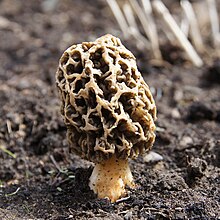| Morchella esculenta | |
|---|---|

| |
| Scientific classification | |
| Domain: | Eukaryota |
| Kingdom: | Fungi |
| Division: | Ascomycota |
| Class: | Pezizomycetes |
| Order: | Pezizales |
| Family: | Morchellaceae |
| Genus: | Morchella |
| Species: | M. esculenta
|
| Binomial name | |
| Morchella esculenta | |
| Synonyms | |
| Morchella esculenta | |
|---|---|
| Smooth hymenium | |
| Cap is conical or ovate | |
| Hymenium attachment is irregular or not applicable | |
| Stipe is bare | |
| Spore print is cream to yellow | |
| Ecology is mycorrhizal or saprotrophic | |
| Edibility is choice | |
Morchella esculenta (commonly known as common morel, morel, yellow morel, true morel, morel mushroom, and sponge morel) is a species of fungus in the family Morchellaceae of the Ascomycota. It is one of the most readily recognized of all the edible mushrooms and highly sought after. Each fruit body begins as a tightly compressed, grayish sponge with lighter ridges, and expands to form a large yellowish sponge with large pits and ridges raised on a large white stem. The pitted yellow-brown caps measure 2–7 centimetres (1–3 inches) broad by 2–10 cm (1–4 in) tall, and are fused to the stem at its lower margin, forming a continuous hollow. The pits are rounded and irregularly arranged. The hollow stem is typically 2–9 cm (1–3+1⁄2 in) long by 2–5 cm (1–2 in) thick, and white to yellow. The fungus fruits under hardwoods and conifers during a short period in the spring, depending on the weather, and is also associated with old orchards, woods and disturbed grounds.